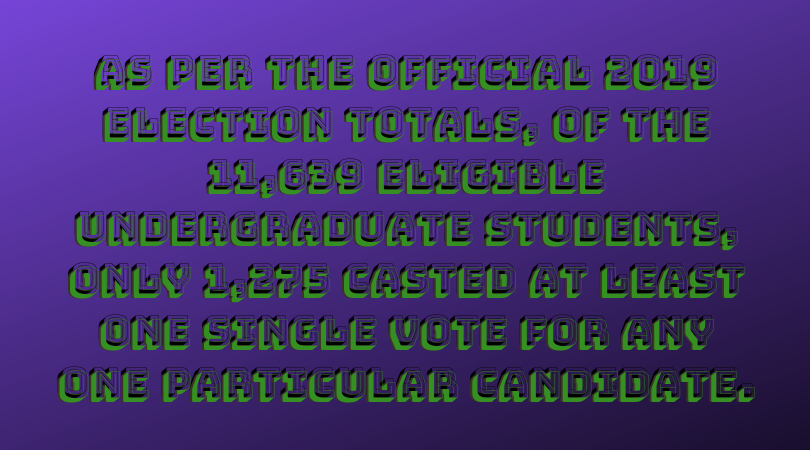2019 USG Election Voter Turnout: What Does it Signify?
Words by Eric Bilach
Illustrations by Katie Herchenroeder
With the 2019 installment of TheCity College of New York’s annual Undergraduate Student Government (USG)elections concluding on Thursday, April 11, the ballots have been casted, allof the votes have been counted, and the results are finally all in. For someCCNY undergraduate students, these elections signify a changing of the guard—anopportunity to usher in new, or preserve past serving, representatives who havecollectively been deemed the best suited for presenting the needs and concernsof the entire student body to the higher administration.
Conversely, other students haverevealed to be quite crossed by the pageantry of these yearly events,dismissing them as mere ostentatious displays of pomp and circumstance ratherthan as a productive means of appointing student officials. Caught in themiddle between these two extremes arises a third category of students—those whoremain indifferent towards the entire process as a whole. As it follows, thestatistics regarding voter turnout that are produced after every election cyclemirror these varied opinions that exist across campus, as well as offer somekey insight into the individual sentiments held by voters and non-voterstowards the USG.
In line with years past, the voterturnout for this most recent election cycle has managed to provide suchinsight. As per the official 2019 election totals, of the 11,639 eligibleundergraduate students, only 1,275 casted at least one single vote for any oneparticular candidate (a grand total of 14,255 votes were officially recorded).A simple calculation of the first two figures determines this year’s voterturnout to be 10.94%. While this may appear to be a meager result consideringit proves that (roughly) only one out of every ten students participated invoting, it is still a marginal increase from last year’s (2018) voter turnoutof 6.15% (740 voters out of 12,036 eligible undergraduate students). Despitethis year’s proliferation of votes; however, these current election totalsdemonstrate the sheer lack of voter participation from an overwhelming majorityof CCNY’s undergraduate student population (89.06%).

In speaking with junior KimberlyVelazquez, she stated that she felt both “motivated” and “encouraged” to votein the most recent USG elections. She elaborated on this point by explainingthat she believes the act of voting to be a “responsibility” that allundergraduate students must exercise, especially when considering that theseelections ultimately determine the individuals who will serve as the direct spokespeoplefor the student body to CCNY administrators and other “higher-ups.” ForKimberly, there exists an inherent self-interest that is tied to the act ofvoting—one that ensures that her individual needs, concerns, and voice, inaddition to those of her peers, will be heard through proper studentrepresentation.
In the discussion on this year’svoter turnout, Kimberly suggested that perhaps part of the reason behind thelack of student participation in election cycles may be the preconceived notionthat the power of the USG is “limited” or, at the very least, “not clearlydefined.” In response, Kimberly rejects this notion on the grounds that,“Student government try their hardest to bring about change and new ideas tothe campus.” Given her relationships with some of the members of the USG, shealso revealed that she is “aware” of the organization’s tremendous work ethic,claiming that, “While it may not always be seen, their effort is definitelyalways there.”
In concurrence with Kimberly’sperspectives, junior Matthew Romano expressed that his position as vice presidentof Teachers of Tomorrow has permitted him to gain first-hand knowledge on theextent of the USG’s powers as an organization, as well as their influence overeach individual member of the undergraduate student body. In a sit-down meetingwith USG members Frantzy Luzincourt, then-Interim Vice President for StudentAffairs, and Hannah Towfiek, Secretary, Matthew learned that the organizationis in fact the “source of funding for all student clubs.” These funds aregenerated through student activity fees, which, at the present time, cost everycontinuing student $14 per academic year. From there, the USG disperses thesefunds equally among the approximately 200 clubs that exist on campus. The USGalso has the ability to push across referendums to the higher administration(as well as the CUNY Board of Trustees) that can influence club funding and, byextension, those clubs’ financial stability.
In terms of relating all of thesedetails on the USG’s list of powers to voter turnout, Matthew holds firmly thatthe majority of undergraduate students, particularly those who do not belong toor are not affiliated with any club, “fail to recognize” the organization’sdirect impact on them, especially with regards to club funding and on-campusevents and activities. In Matthew’s own words, the USG operates as sort of “themen and women behind the curtain.” By this, Matthew confirms the notion thatthe role the USG plays in fundraising, promoting, and running many of theannual functions - including Lavender Fever Homecoming Week, the Welcome Backevents hosted by the Department of Student Life, bashes hosted by the CaribbeanStudents Association, among others - that take place across campus is rarelyever “unveiled” to the student public. As this suggests, even if a student isto partake in such festivities throughout the academic year, it is highlyunlikely that they will be made aware of the extent of the USG’s involvement.Thus, their view on the organization as an entity remains relatively unchanged,which is ultimately reflected in the voter turnout of each election cycle.

Speaking from the entirely oppositeend of the spectrum, other CCNY undergraduate students hold a much morecritical perspective on the USG and their purposes and functions as a studentrepresentative organization. According to junior Omar Elsayed, “There is trulyno point in voting for the USG at a commuter school. The vast majority of uscome to school each day, then leave directly for home. So, when it comes downto it, the USG and their initiatives have no genuine effect on most of thestudent populace—only for those who care to participate in campus activities,many of which do not.”
Omar’s point-of-view regarding theUSG’s influence on undergraduate students appears to fall in direct conflictwith that of Matthew’s. Taking into account that CCNY can be defined as a“commuter school” (given that, via a compilation of various statistics, anestimated 95% of the entire student population resides off-campus), Omar’ssupposition may hold some weight. Omar does not contest that USG policies mayhave some bearing over certain aspects of student life, rather he is arguingthat said policies are frequently neglected and ignored by the college’simmense commuter population whose time spent on campus each day, in most cases,is typically limited to only class hours.
Further, in addition to this debateover the USG’s relevance to the undergraduate student body, Omar has alsoquestioned the legitimacy of the organization and their positions. Omar claims,“In my opinion, USG roles are ghost positions students run for just to put ontheir résumés.” He expounded on this point by criticizing the entire USGelection process as a whole, wherein he asserted that students running foroffice who “pander” for votes in the NAC Rotunda and offer “ambiguous” campaignideas and platforms have not provided undergraduate students, includinghimself, with any incentive to vote whatsoever.
As CCNY transitions into the2019–2020 academic year alongside the newest incarnation of the USG, improvingvoter turnout is already at the forefront of the organization’s agenda. In aninterview with recently elected President of the USG Frantzy Luzincourt, herevealed that he is “proud” of the increase in student participation for thismost recent election cycle. Regardless of such a feat, the newly appointedleader added, “[The USG] definitely still [has] more work to do and, hopefully,that number continues to increase.”
With opinions and sentiments of theUSG on campus ranging from vehemently critical to utterly indifferent to highlysupportive, Frantzy encourages undergraduate students to “become more directlyinvolved with the USG” in order to 1) “learn more about how the campus works”and 2) enhance one’s daily college experience. By expanding on their current“grassroots approach” to campaigning, as well as their “aggressive social mediastrategy” on Facebook and Instagram, Frantzy and his fellow USG members aim toengage with undergraduate students at a more individual and intimate level. Ifsuch methods prove to be a success, perhaps voter turnout will continue torapidly increase in subsequent election cycles; however, this remains to beseen as only time will tell whether or not this current USG administration willbe able to have a positive impact on CCNY undergraduate voter participation.





